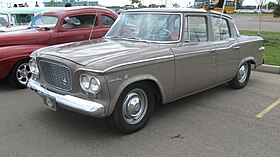Studebaker Lark
| Studebaker Lark | |
|---|---|

1960 Studebaker Lark Four-Door Sedan
|
|
| Overview | |
| Manufacturer | Studebaker |
| Also called | Studebaker Cruiser (1963–1966) Studebaker Standard (1963 only) Studebaker Commander (1964 2nd series - 1966) Studebaker Daytona (1964 2nd series - 1966) Studebaker Wagonaire (1966 only) |
| Production | 1959–1966 |
| Body and chassis | |
| Body style | 2-door sedan 4-door sedan 2-door coupe 2-door convertible 2-door station wagon 4-door station wagon |
| Layout | FR layout |
| First generation | |
|---|---|

1961 Studebaker Lark VI
|
|
| Overview | |
| Production | 1959–1961 |
| Assembly |
South Bend, Indiana Hamilton, Ontario, Canada, Kaiser Frazer of Israel, Haifa, Israel Australia |
| Powertrain | |
| Engine | 170 cu in (2.8 L) I6 259 cu in (4.2 L) V8 |
| Dimensions | |
| Wheelbase | 2,790 mm (110 in) Wagon: 2,900 mm (110 in) |
| Second generation | |
|---|---|

1963 Studebaker Lark Regal 4-Door Sedan
|
|
| Overview | |
| Production | 1962–1963 |
| Assembly |
South Bend, Indiana Hamilton, Ontario, Canada Kaiser Ilin Industries, Haifa, Israel Australia |
| Third generation | |
|---|---|

1964 Studebaker Daytona 4-door sedan
|
|
| Overview | |
| Production | 1964–1966 |
| Assembly |
South Bend, Indiana (through December 1963 only) Hamilton, Ontario, Canada A.Ilin Industries, Haifa, Israel Australia |
| Powertrain | |
| Engine | 194 cu in (3.18 L) I6 3.8 L Chevrolet 230 I6 283 cu in (4.64 L) V8 |
The Studebaker Lark is a "compact car" which was produced by Studebaker from 1959 to 1966.
From its introduction in early 1959 until 1962, the Lark was a product of the Studebaker-Packard Corporation. In mid-1962, the company dropped "Packard" from its name and reverted to its pre-1954 name, the Studebaker Corporation. In addition to being built in Studebaker's South Bend, Indiana, home plant, the Lark and its descendants were also built in Hamilton, Ontario, Canada, from 1959 to 1966 by Studebaker of Canada Limited. The cars were also exported to a number of countries around the world as completed units and completely knocked down (CKD) kits.
Lark-based variants represented the bulk of the range produced by Studebaker after 1958 and sold in far greater volume than the contemporary Hawk and Avanti models. Beginning with the 1963 Cruiser, the Lark name was gradually phased out of the company catalog and by early 1964, Lark-based models were being marketed under Commander, Daytona and Cruiser nameplates only. The Studebaker company, which celebrated its 100th anniversary in 1952, ceased automobile production in 1966.
At the time the Lark was conceived, Studebaker-Packard Corporation was under a management contract with Curtiss-Wright Aircraft Company. Studebaker-Packard had been losing money for a few years when company president Harold E. Churchill came up with the idea of abandoning the full-size car market in favor of building a new compact car that he hoped would save the company.
The Lark was ingeniously designed around the core bodyshell of the full-sized 1953–1958 Studebakers. By reducing the front and rear overhangs and shortening the wheelbase ahead of the firewall, the car could still seat six people comfortably and hold a surprising amount of luggage. It was hoped that the new model would save America's oldest vehicle manufacturer when it was launched in the fall of 1958 as a 1959 model, much like the 1939 Studebaker Champion had saved the company in the years prior to World War II. In fact, it was the Champion which Churchill specifically took as his inspiration for the Lark.
...
Wikipedia
